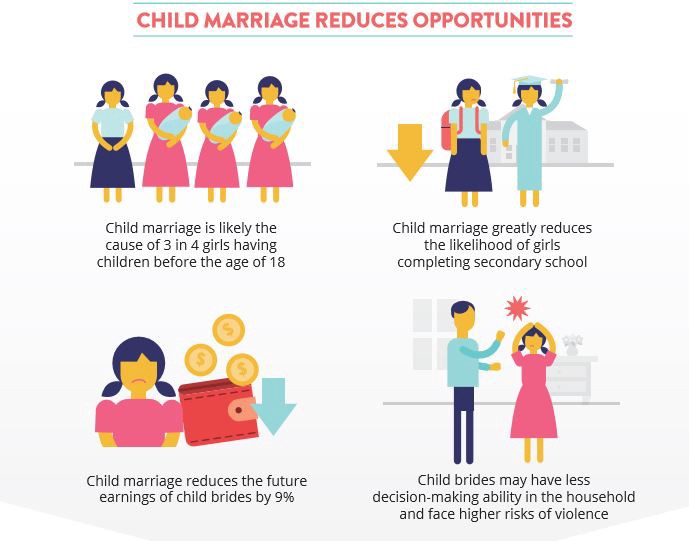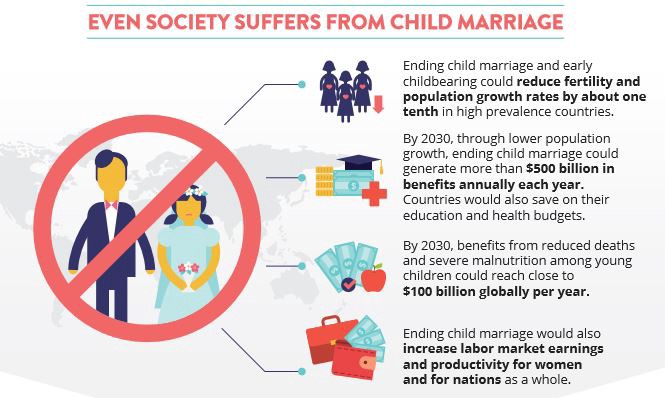The rippling economic impacts of child marriage
By Suzanne Petroni, LancetYouth Commissioner, Senior Director, Global Health Youth and Development, ICRW and Quentin Wodon, Adviser, Education Sector, World Bank

Globally, more than 700 million women alive today married before the age of 18. Each year, 15 million additional girls are married as children, the vast majority of them in developing countries. Child marriage is widely considered a violation of human rights, and it is also a major impediment to gender equality. It profoundly affects the opportunities not only of child brides, but also of their children. And, as a study we issued this week concludes, it has significant economic implications as well.
Every day, we learn more about the drivers of child marriage in different contexts and the ways in which to help end this harmful practice. But to date, we have had only limited information on the negative impacts of the practice across countries, and very little understanding of its economic costs.
The International Center for Research on Women (ICRW) and the World Bank have been collaborating on a multi-year research project to assess these impacts and costs. We looked at the impacts of child marriage on early childbearing, fertility, contraceptive use, intimate partner violence, educational attainment, earnings in adulthood, and decision-making ability within the household, among other outcomes. We also considered impacts on the children of child brides, including, for example, their risk of being stunted and of dying before age five.
Our collaboration, supported by the Bill & Melinda Gates Foundation, the Children’s Investment Fund Foundation and the Global Partnership for Education, concludes that child marriage imposes very significant social and economic costs, not only at the individual level, but also for societies and for the intergenerational transmission of poverty.
 We unveiled our findings at the World Bank’s headquarters in Washington, DC. Our study finds that child marriage could cost developing countries trillions of dollars by 2030 — the year by which the UN, through its Sustainable Development Goals (SDGs), calls for the elimination of the practice.
We unveiled our findings at the World Bank’s headquarters in Washington, DC. Our study finds that child marriage could cost developing countries trillions of dollars by 2030 — the year by which the UN, through its Sustainable Development Goals (SDGs), calls for the elimination of the practice.
By far the largest economic cost related to child marriage is from its impact on fertility and population growth. By contributing to larger families and, in turn, population growth, child marriage delays the demographic dividend that can come from reduced fertility and investments in education. The associated cost could run in the trillions of dollars globally (in purchasing power parity) between now and 2030.
Other costs are substantial as well. By 2030, countries could see tens of billions of dollars in benefits from the reduction that ending child marriage would bring in stunting and child mortality.
Ending child marriage would also have tremendous positive effects on girls’ education, which in turn would bring many additional benefits. Increased educational attainment for girls contributes to women having fewer children later in life, increases their lifetime expected earnings, improves household income, reduces their likelihood of experiencing intimate partner violence and increases their ability to make decisions. In relation to earnings, our study shows that the interruption of education as a result of child marriage reduces the earnings of child brides in adulthood by 9 percent on average, which has negative impacts for households and national economies.

To ground these figures at the country level, consider this:
In Niger, the country with the highest prevalence of child marriage in the world, eliminating child marriage in 2015 would have led by the year 2030 to annual benefits of up to $1.7 billion in additional welfare, $327 million in savings to the education budget, $34 million through reduced infant mortality, and $8 million through reduced child stunting. In addition, earnings today are $188 million below what they could have been without child marriage, and these losses would grow over time if child marriages continue. Altogether, failing to end child marriage would cost the country billions of dollars, with the impact falling disproportionately on the poor.
Findings from the study demonstrate that child marriage is not only a social issue, it is very much an economic issue. We hope that by demonstrating these economic costs, we will be able to foster broader investments to end this harmful practice and ensure that all girls have access to the opportunities and the futures that they deserve.
This blog was originally posted on Medium and on the World Bank blog. For more insights about the Economic Impacts of Child Marriage, visit website.
